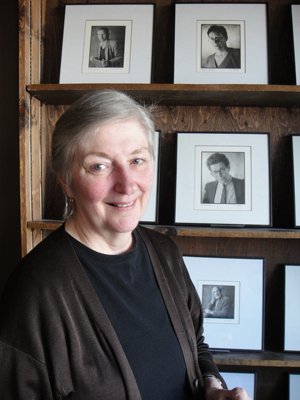On the morning I visited Denver's Tattered Cover Book Store, the place was bustling with activity. Customers wandered up and down the central staircase, carrying books tucked under their arms. They stopped to browse the spacious aisles, scanning titles on the shelves. They lingered in the downstairs café, eating as they flipped through magazines from the enormous periodical section.

The reason for the crowds had partly to do with the influx of writers who had traveled to Denver this weekend for the Association of Writers & Writing Programs Conference, and partly with the fact that it was opening day of the Major League Baseball season—the sidewalks were filled with fans headed to nearby Coors Field, home of the Colorado Rockies, and before the game, many of them stopped at Tattered Cover. The store's location, in the LoDo (Lower Downtown) area of Denver, is a success story of urban revitalization. This neighborhood is the oldest section of Denver, and like the boom-and-bust economy of this western city, it has had its fair share of downturns. In 1988, however, the city council created the Lower Downtown Historic District with the mission to preserve the architectural and historical assets of the area and to spur economic investment and growth.
Because of her belief in this project and the need for community-oriented business districts, Joyce Meskis, owner of Tattered Cover, purchased the warehouse building at 16th and Wynkoop with a business partner in 1990, and subsequently moved her administrative offices and the shipping-and-receiving operations for her Cherry Creek store, which opened in 1974, to this location. A few years later, she opened a second Tattered Cover store here, as well as a coffee shop and newsstand. By 1996 the LoDo store had substantially expanded and today occupies two floors over approximately twenty thousand square feet, including a café and a dedicated special-events area that accommodates up to 250 people.
The store has since become as much a destination for the local community as it has for writers. From the moment you walk in, you feel a sense of ease and peacefulness. There are overstuffed chairs and couches throughout both floors, as well as spacious tables in the café area. The guiding aesthetic is a wonderful mix of the old (worn hardwood floors downstairs, exposed rafters and hand-hewn support beams) and the new (forest green carpet upstairs, a selection of organic and local options at the café). The place feels vital. It feels vigorous.
The same could be said of Meskis. Though soft spoken, she possesses an engaging and charming personality that immediately put me at ease. She radiates a type of calm that seems unflappable by the challenges of daily life. Yet in conversation she is the first to poke fun at herself and the many obstacles she has faced in her thirty-six years as a bookseller—not just in terms of running a business, but also advocating for First Amendment rights and helping to nurture the social and literary communities of Denver. In fact, Tattered Cover hosts more than five hundred readings a year among its three locations. So it was fitting that we sat down for our talk beside a fireplace at the back of Tattered Cover's expansive event space, surrounded by black-and-white photographs of many of the authors who've read at the store during its nearly four decades of existence.
How did you come to bookselling?
I came to bookselling accidentally. I
was intent on teaching at the university level.
Here in Denver?
No, I didn't have a place in mind. I
grew up in Chicago on the South Side, and I was very driven in terms of my
direction in life. I was determined I was going to get the zillionth degree,
and I wanted to have a life that was full of the usual things—marriage,
children. I could see myself at an excellent university teaching brilliant
students all day long, walking home with a briefcase in hand, kicking the fall
leaves as I approached my nice but not ostentatious house, hearing strains of
Chopin being played by my children through the open French doors. [Laughter.] It didn't quite work out that way.
What year was this?
I graduated high school in 1959. Then
I went to college.
Did you go to school in Chicago?
No, I went to Purdue [in Indiana]. I
was a math major, believe it or not. It was always a toss-up, and I eventually
shifted to English. My parents didn't have much money, but they were able to
pay for my first year. So I always had part-time jobs in the summers. But then
I married young, while we were in school, and I needed to get more work during
the school year. And soon I found myself working in bookstores to help pay the
tuition.
This was at Purdue?
Yes. But then my husband finished his
graduate degree and we moved to Colorado. All the while I was still working in
bookstores and libraries to help pay the tuition bills. And after some time—I
was in graduate school then—I woke up one morning literally staring at the
ceiling and said, "You idiot, don't you know that you've been doing what you love
all these years? Why don't you just get on with it?" So I dropped out of
graduate school and I got more serious about the book business. Around this
time the marriage ended, and I had two small children.
When was this?
1973. We were still pretty young, so
we didn't have much savings. But I took my half and began pursuing the book
business. Fast forward a year or so and a little store in the Cherry Creek area
of Denver came up for sale. It was called the Tattered Cover, and it was three
years old. It was a small storefront—only 950 square feet—and carried only
new books, despite its name. So, I did a little business plan on an envelope
with a pencil and figured I could pull it off. The bad news was that the owner
wanted what seemed like a huge amount of money at the time. But the good news
was that he was willing to carry the note, to be the banker. And the other
piece of good news was that he didn't want much money down. So I figured out
what I could do and I made an offer, which was promptly rejected.
Some time went by and I decided, through the urging of a friend, to go see what was going on, because there was no ownership transition of the store that was apparent. It turned out that someone else had made a better offer earlier, but the deal had fallen through. I don't know why the owner didn't come back to me afterward. Who knows? But, to make a long story somewhat shorter, I made another offer. I borrowed some money from my uncle in California and that offer was accepted in September 1974, and ownership transferred to me.








